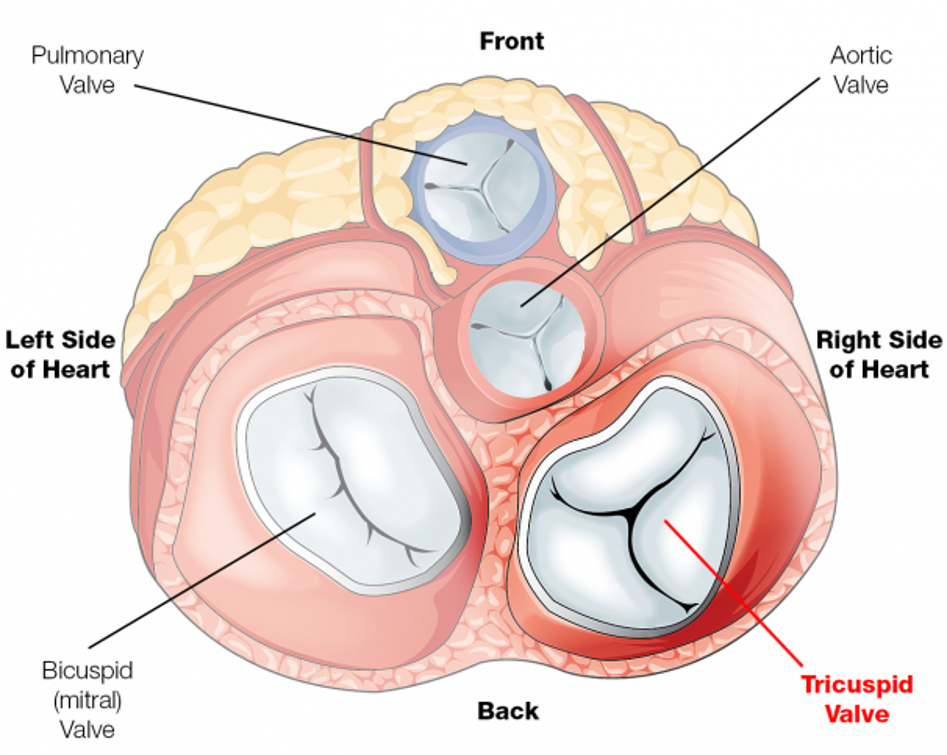Tricuspid Valve Disease
Tricuspid Valve Disease
The tricuspid valve is one of the two main valves on the right side of your heart. Normally, the tricuspid valve has three flaps (leaflets) that open and close, allowing blood to flow from the right atrium to the right ventricle in your heart and preventing blood from flowing backward.
Tricuspid valve disease occurs when the tricuspid valve doesn’t work properly. In some cases, the tricuspid valve is narrowed and doesn’t allow enough blood to pass through into your right ventricle (stenosis).
In other cases, the valve doesn’t close tightly enough, allowing blood to leak backward into the right atrium (regurgitation).

Causes Of Tricuspid Valve Disease
Problems with the tricuspid valve may develop over time (acquired).
Tricuspid valve stenosis is most commonly caused by inflammation from rheumatic fever, a disease that is related to strep infections; however, rheumatic fever is rare in the United States and other developed countries, so tricuspid valve stenosis is becoming less common.
Tricuspid valve regurgitation is caused by destruction of the valve leaflets by infection, or by diseases that cause enlargement of the right ventricle, which pulls the leaflets apart.
The enlargement or bulging may be a result of conditions such as heart failure, high blood pressure in the arteries in your lungs (pulmonary hypertension), or generalized weakness of the heart muscle (cardiomyopathy).
Symptoms Of Tricuspid Valve Disease
- Pulsing In Your Neck
- Fatigue
- Weakness
- Shortness Of Breath
- Swelling
Mild tricuspid valve disease often does not cause any symptoms.
Severe tricuspid valve disease may cause a pulsing in your neck, fatigue, weakness, shortness of breath, and swelling.
Tricuspid valve disease is not nearly as common as mitral or aortic valve disease. It is sometimes seen in combination with other valve diseases, such as mitral valve regurgitation.
Diagnosis And Treatment Options
Your doctor can usually diagnose tricuspid valve disease based on your medical history, risk factors, a physical exam, and results from tests and procedures.
There is no one test that can diagnose tricuspid valve disease, so your doctor may recommend one or more of the following: EKG (electrocardiogram), chest x-ray, echocardiogram (echo), coronary angiogram, or a cardiac MRI.
A faulty tricuspid valve that is not causing symptoms may not need any treatment, and mild symptoms may be treated with medication. More severe symptoms, however, can require surgery. Cardiothoracic surgeons typically prefer to repair the tricuspid valve when possible, although replacement is sometimes necessary. Surgery on the tricuspid valve can be done in conjunction with other valve surgeries.
Together with you and your medical team, your doctor will determine the best treatment option based on your symptoms and test results.
Medication
Medication cannot correct a faulty tricuspid valve, but it can help treat the underlying condition (such as heart failure) and reduce symptoms.
Tricuspid Valve Repair
If your symptoms are more severe, your tricuspid valve may need to be repaired. A cardiothoracic surgeon can perform a surgical procedure to reshape tissue, patch holes or tears in the valve, or separate flaps that have fused together.
There are two different surgical approaches that can be utilized: traditional or minimally invasive.
During traditional tricuspid valve surgery, the surgeon makes a 6- to 8-inch long incision down the center of your sternum (breastbone) to open the chest, providing direct access to your heart. In minimally invasive surgery, the cardiothoracic surgeon makes a 2- to 4-inch, J-shaped incision that opens part of your chest. This potentially can reduce hospital stay, and help speed up your recovery time.
Minimally invasive surgery is not appropriate for all patients, but your cardiothoracic surgeon will recommend the surgical approach that is safest for you based on your individual symptoms and circumstances.
Tricuspid Valve Replacement
If the tricuspid valve is too damaged, it may need to be replaced. Biological valves (made of tissue) are more often used to replace the tricuspid valves. Mechanical valves (made of metal) are also an option, but are more commonly used when replacing the mitral valve or aortic valve.
Biological valves are made either from animal tissue, human cadavers, or your own tissue. If you do have a mechanical valve, you will have to take blood thinning medication for the rest of your life to prevent blood from clotting on the metal surface of the valve.
Your medical team will discuss the advantages and disadvantages of both valve types with you prior to surgery.
Like tricuspid valve repair, replacement can be done minimally invasively or with traditional open-heart surgery.
While most people who undergo tricuspid valve surgery have a full recovery, potential complications include bleeding, infection, blood clots, irregular heart rhythm, or heart attack.
Recovery
Immediately after surgery, you likely will have a tube in your throat so that your breathing can be assisted by a ventilator. The tube will be removed once you are able to breathe completely by yourself.
You likely will spend several days recovering in the hospital, although the total length of time depends on your overall health, as well as the specific procedure you underwent, with minimally invasive procedures often requiring less recovery time.
Once you’re home, it may be several more weeks until you are able to go back to work, depending on your job. Everyday activities, such as driving and lifting heavy objects may be restricted for a period of time. Blood thinning medication may be prescribed for 6 weeks to 3 months after surgery if you have a biological valve and for life if you have a mechanical valve.
After your wounds have healed, you should be able to get back to your normal activities.
Always tell a doctor about your valve surgery before any medical procedure. This includes your dentist, as you may require preventative antibiotics when having dental work.
